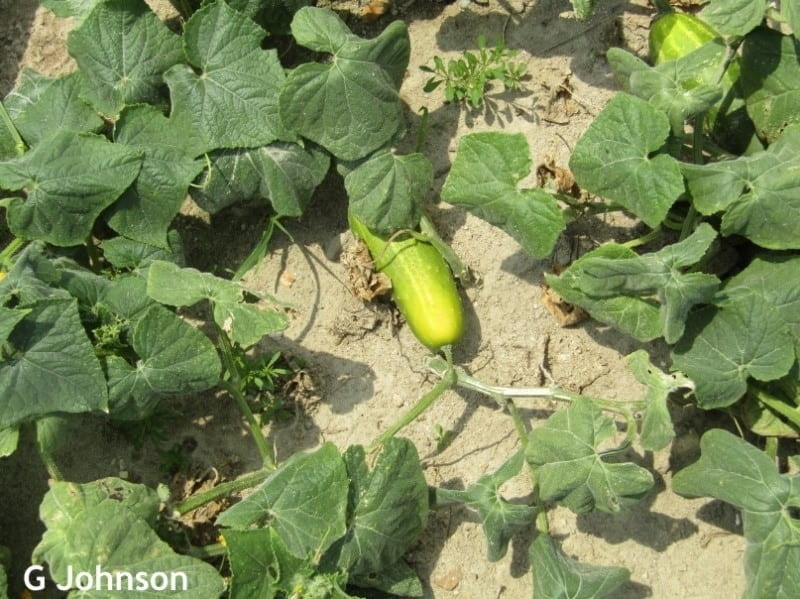Gordon Johnson, Extension Vegetable & Fruit Specialist; gcjohn@udel.edu
July is the month that we see the highest temperatures and often have cloud free, high light intensity days and long day lengths. Under these conditions, good leaf cover is essential for producing high quality fruits. Lack of leaf cover will expose fruits to high levels of radiation and cause excessive heating of the fruit surface. This can lead to a variety of disorders including sunburn, sunscald, fruit yellowing, fruit cracking, and shriveled fruit.
Lack of leaf cover often occurs due to storm damage where high winds or hail damage leaves. After damaging storms, attempts should be made to promote new leaf cover as quickly as possible by sidedressing or fertigating with nitrogen fertilizer and by irrigating.
A second, temporary loss of leaf cover occurs during hot periods when plants are allowed to wilt. Just a few hours without cover under high heat and light can cause severe damage to fruits. This is most severe in dark colored fruit such as peppers and cucumbers. Irrigation management is critical to limit fruit damage due to wilting.
Lack of leaf cover can also be due to lack of plant vigor and poor plant growth which may have a variety of causes such as underfertilization, deficiencies, water stress, wet soil, compacted soil, hot soil conditions or other soil, water, or fertility related issues. Finding the root cause will be critical to address and correct these growth-limiting factors and improve leaf cover.
Diseases that reduce leaf production, attack leaves, or cause wilting can reduce leaf cover and lead to fruit disorders. Leaf feeding insects can also contribute to leaf area losses. Protecting plants against expected diseases and insects along with scouting for signs of infections or infestations is critical to maintain canopies. Air pollution damage can also cause losses of leaf cover in sensitive crops and varieties.
Staking and pruning practices are also important to manage leaf cover. Excessive pruning of tomatoes can expose fruits to excess radiation leading to fruit damage. Single or double stem training systems, as are often used in greenhouses and high tunnels, are at most risk. Staking peppers has been shown to reduce fruit damage by maintaining leaf cover over developing pepper fruit.
One common problem in high radiation exposure conditions and lack of leaf cover is sunburn. We commonly see sunburn in watermelons, tomatoes, peppers, eggplants, cucumbers, apples, strawberries, and brambles (raspberries and blackberries).
There are three types of sunburn which may have effects on the fruits. The first, sunburn necrosis, is where skin, peel, or fruit tissue dies on the sun exposed side of the fruit. Cell membrane integrity is lost in this type of sunburn and cells start leaking their contents. The critical fruit tissue temperature for sunburn necrosis varies with type of fruit. Research has shown that the fruit skin temperature threshold for sunburn necrosis is 100 to 104°F for cucumbers; 105 to 108°F for peppers, and 125 to 127°F for apples. Fruits with sunburn necrosis are not marketable. Injury may be white to brown in color.
Sunburn necrosis on pepper.
The second type of sunburn injury is sunburn browning. This sunburn does not cause tissue death but does cause loss of pigmentation resulting in a yellow, bronze, or brown spot on the sun exposed side of the fruit. Cells remain alive, cell membranes retain their integrity, cells do not leak, but pigments such as chlorophyll, carotenes, and xanthophylls are denatured or destroyed. This type of sunburn browning occurs at a temperature about 5°F lower than sunburn necrosis (i.e. 115 to 120°F in apples). Light is required for sunburn browning. Fruits may be marketable but will be a lower grade.
The third type of sunburn is photooxidative sunburn. This is where shaded fruit are suddenly exposed to sunlight as might occur with late pruning, after storms where leaf cover is suddenly lost, or when vines are turned in drive rows. In this type of sunburn, the fruits will become photobleached by the excess light because the fruit is not acclimatized to high light levels, and fruit tissue will die. This bleaching will occur at much lower fruit temperatures than the other types of sunburn. Damaged tissue is often white in color.
Fruit yellowing in cucumber due to loss of chlorophyll with exposure due to inadequate leaf cover.


